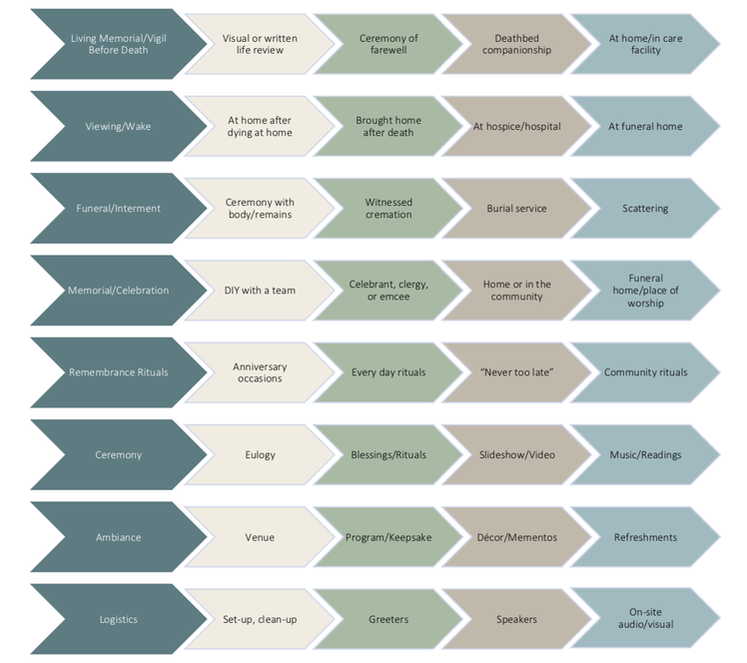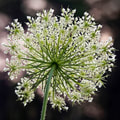Ceremony and Community EngagementRitual and ceremony, subtle or elaborate, provides the opportunity to connect more deeply—whether to the deceased, to family and community, to ancestry and culture, or to the natural cycle of life and death. Often we find ourselves creating meaning by marking a moment in simple ways—a spontaneous acknowledgement of what is happening or what has already happened—that has no formal structure but is meaningful and enriching nonetheless. While conventional funeral ceremonies are becoming less frequent, as humans we are hardwired for some form of ceremony to mark the end of someone's life. What that looks and feels like is entirely up to us. The chart at the end of this page illustrates a range of options for hands-on participation in making meaning through ritual and ceremony.
|
On This Page
|
Before Death Rituals and Ceremony
In anticipated death, both the dying and their family and friends may have the opportunity to take that time for reflection.
- Legacy Projects in writing, spoken, or other form leave a message of importance for descendants. In Jewish tradition, this is called an ethical will (zava'ah, in Hebrew).
- Life Review can smooth the dying process, presenting a chance to tie up loose ends and make meaning of a life.
- Living Memorials are gaining popularity, inviting the dying person's sphere of loved ones into a ceremony of farewell and support while they are there to design and enjoy it.
- Vigils During the Dying Period are meant to comfort the dying and the living, creating community by having someone nearby at all times.
- End-of-Life Doulas are poised to assist families with these aspects of dying, some as volunteers and others for pay.
- Twilight Brigade is an organization of volunteers who ensure that no military veteran dies alone.
- No One Dies Alone is an organization of volunteers who provide a compassionate presence in nursing homes and senior care facilities during the final 24-36 hours of life.
Marking the Moment After Death
By keeping or bringing a loved one home after death, family, friends, neighbors, and co-workers have the opportunity to mark the passing in an intimate, familiar environment. Slowing the pace of activity after the dying period allows everyone space to reflect and to take in what has occurred. Each family is different and will find their own way to make meaning of the death. Here are some to consider as a starting point.
- After Death Vigils invite others to come into the home to sit with the body for a period of time, often overnight. In the Jewish faith, this is called sitting shiva, where the body is not left alone until burial.
- Viewing, Visitation, Wake are all terms we tend to use interchangeably in a formal setting, but in the home it simply means that mourners are invited into the home at times agreeable to the family over a period of hours or days to witness the death and comfort the living.
- Ceremony of any kind can be conducted at home or at any other location, incorporating clergy, musicians, poets, and others who wish to contribute to honoring the memory of the deceased.
- Memorials are typically held after the body has been buried or cremated, so there is no body present.
- Funeral Services are with the body present, either in the home or at a church or facility elsewhere.
- Graveside Services mark the moment of interment in the earth, giving the family a chance to participate.
- Scattering Ceremony is a gathering of mourners to bury, float, or literally scatter cremated remains in the air.
Ceremony and Ritual

For many of us, the time around a death is confusing and unsettling, and we often don't feel confident about what we say or how we say it. We have lost the art of condolence. Home funerals give us the opportunity to relearn the language of death within community, and to use it to make sense of what has happened and express our emotions and hopes.
We have come to expect that ceremonies are one-time events, and rituals are only religious. With more people dying and staying in the home for the vigil period, we are learning that ritual is a powerful tool for coping and making meaning that can be spontaneous, individual or collective, or formal.
Ordained clergy, interfaith ministers, and celebrants are all trained to varying degrees to assist families in creating personal and meaningful ceremonies that are story-centered and family-led.
The following websites offer free ceremonial resources, such as poems, songs, hymns, quotations, prayers, and other elements for families to use to create their own. Some also describe ceremony features according to the type of event and the time they may be used.
The Inspired Funeral
We have come to expect that ceremonies are one-time events, and rituals are only religious. With more people dying and staying in the home for the vigil period, we are learning that ritual is a powerful tool for coping and making meaning that can be spontaneous, individual or collective, or formal.
Ordained clergy, interfaith ministers, and celebrants are all trained to varying degrees to assist families in creating personal and meaningful ceremonies that are story-centered and family-led.
The following websites offer free ceremonial resources, such as poems, songs, hymns, quotations, prayers, and other elements for families to use to create their own. Some also describe ceremony features according to the type of event and the time they may be used.
The Inspired Funeral
Public Announcements of the Death
Who Needs to Be Notified
In the past, it was customary to file a death notice in a paper near where the deceased lived and did business in order to notify known creditors so that they have the chance to make a claim against the estate. It is not required by the state, since the filing of the death certificate with Vital Records is now considered sufficient record and proof. Today, posting a notice in the paper is more of a social convention, letting everyone in your world know that a family member has died.
Publishing a Death Notice or Obituary
Families may file obituaries and memorial notices. A newspaper may ask to see a death certificate if it is not being submitted by a funeral director. While some news outlets may still provide a death notice or obituary as a public service (or as a news item in the case of a public person), today these are typically handled by an advertising department charging by word count, number of lines, or column inches.
Online Memorial Websites are a good way to involve family and friends by providing a place to post condolences, and share memories and photos. Families can use the site to designate nonprofit charity donations and alert people to changes in plans. Typically a funeral home or cremation provider will offer their customers an online posting on their site at no additional charge. To lower costs of a published obituary, a longer version can be posted online with the paid notice including this web link for more details. Some families use Facebook and other social media sites for this purpose. There are also a growing number of online obituary and memorialization sites, many free, such as LifePosts. (See Elements of Ceremonies below for more information.)
In the past, it was customary to file a death notice in a paper near where the deceased lived and did business in order to notify known creditors so that they have the chance to make a claim against the estate. It is not required by the state, since the filing of the death certificate with Vital Records is now considered sufficient record and proof. Today, posting a notice in the paper is more of a social convention, letting everyone in your world know that a family member has died.
Publishing a Death Notice or Obituary
Families may file obituaries and memorial notices. A newspaper may ask to see a death certificate if it is not being submitted by a funeral director. While some news outlets may still provide a death notice or obituary as a public service (or as a news item in the case of a public person), today these are typically handled by an advertising department charging by word count, number of lines, or column inches.
Online Memorial Websites are a good way to involve family and friends by providing a place to post condolences, and share memories and photos. Families can use the site to designate nonprofit charity donations and alert people to changes in plans. Typically a funeral home or cremation provider will offer their customers an online posting on their site at no additional charge. To lower costs of a published obituary, a longer version can be posted online with the paid notice including this web link for more details. Some families use Facebook and other social media sites for this purpose. There are also a growing number of online obituary and memorialization sites, many free, such as LifePosts. (See Elements of Ceremonies below for more information.)

